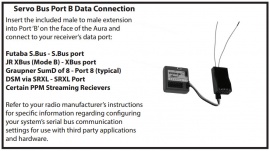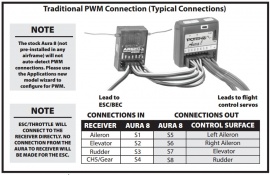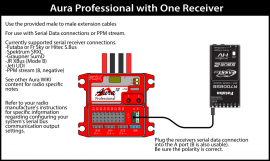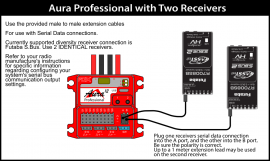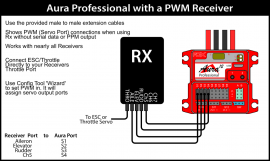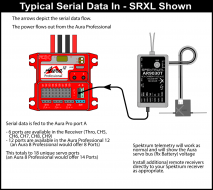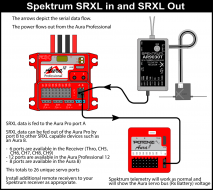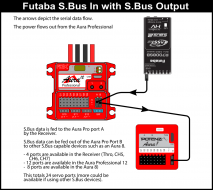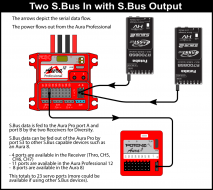Difference between revisions of "Aura/Install"
(Created page with "==Installation Overview== There are five major steps in installing your Aura and preparing it for flight which are usually done in this order: Warning: Remove the propeller or...") |
|||
| (237 intermediate revisions by 2 users not shown) | |||
| Line 1: | Line 1: | ||
| + | {{DISPLAYTITLE:Install Aura}} | ||
==Installation Overview== | ==Installation Overview== | ||
| − | + | <blockquote> | |
| − | Warning: Remove the propeller or unplug the motor or take other action as needed to disable the power system before adjusting Aura settings or making other adjustments to your model. | + | '''Warning:''' Remove the propeller or unplug the motor or take other action as needed to disable the power system before adjusting Aura settings or making other adjustments to your model. |
| + | There are three major steps while installing your Aura. | ||
#Physical Mounting and Installation in Airframe | #Physical Mounting and Installation in Airframe | ||
#Transmitter Setup | #Transmitter Setup | ||
#Wiring Connections | #Wiring Connections | ||
| − | + | ||
| − | + | After completing the installation steps, you must [[Aura/Configure|Configure the Aura]]. | |
| + | |||
| + | </blockquote> | ||
===1. Physical Mounting and Installation in Airframe=== | ===1. Physical Mounting and Installation in Airframe=== | ||
| − | + | *Mount a standard '''Aura 8''' to the airframe using the included double-sided foam tape. (Never use hook-and-loop tape to mount an Aura!)<br /> | |
| − | Mount | + | *Mount an '''Aura Professional 8 or 12''' using the included grommets and screws. It is a good practice to remove the screws and put a small amount of CA glue into the holes to strengthen the screw interface. (you may also use bolts and lock-nuts of your choice for high vibration environments) |
| − | The Aura may be installed in any convenient location in the fuselage, noting: | + | |
| − | The unit may be mounted upright or inverted as required in your installation. | + | Please observe the following rules for properly mounting your Aura. Any deviation from these explicit conditions could cause improper function of the device and may result in a crash. |
| − | The unit may be mounted in the longitudinal or lateral axis in any orthogonal orientation. | + | *The Aura may be installed in any convenient location in the fuselage, noting: |
| − | You will later use the Aura app to properly configure the orientation. ( | + | **The unit may be mounted upright or inverted as required in your installation. |
| − | Thoroughly clean the area to which the Aura will be mounted. Any surface dirt, dust, grease, or oil will severely marginalize | + | **The unit may be mounted in the longitudinal or lateral axis in any orthogonal orientation. |
| − | Ensure that the mounting surface is solid and not susceptible to flexing or movement. Mount the Aura. | + | *You will later use the Aura app to properly configure the orientation. (''Note:'' Standard Aura 8 users should refer to the Quick Start Guide for the two orientations supported by Quick Setup if you choose to use that setup process) |
| − | If installing in a high-performance airplane (larger than a typical park | + | *Thoroughly clean the area to which the Aura will be mounted. Any surface dirt, dust, grease, or oil will severely marginalize any foam tape’s strength. |
| + | *Ensure that the mounting surface is solid and not susceptible to flexing or movement. The movement of a poorly mounted Aura can cause a self-exiting feedback-loop with the servos. Mount the Aura securely on a '''stiff''' platform. | ||
| + | *If installing in a high-performance airplane (larger than a typical park flyer), place a Hook-and-Loop strap around the unit (all Auras) to prevent it from becoming dislodged during high-energy maneuvering. | ||
===2. Transmitter Setup=== | ===2. Transmitter Setup=== | ||
| − | |||
| − | |||
| − | |||
| − | |||
| − | |||
| − | |||
| − | + | The Aura has presets for Spektrum, Futaba, Graupner, JR, FRSky, and Jeti Transmitters. | |
| + | *FRSky users should refer to the section on [[Aura/FrSkyUse|FR Sky Use]] | ||
| + | *Spektrum users should refer to the section on [[Aura/SpektrumUse|Spektrum Use]] | ||
| + | *Futaba users should refer to the section on [[Aura/FutabaUse|Futaba Use]] | ||
| + | *Jeti‡ users should refer to the section on [[Aura/JetiUse|Jeti Duplex Use]] | ||
| + | *Hitec users should refer to the section on [[Aura/HitecSbusUse| Hitec Use]] | ||
| + | *Graupner users should refer to the section on [[Aura/GraupnerHottUse|Graupner Hott Use]] | ||
| + | *JR DMSS users should refer to the section on [[Aura/JRDMSSUse|JR DMSS Use]] | ||
| + | |||
| + | *If your transmitter brand is not Listed, you may configure the Aura to use a 'Custom' transmitter and then 'Learn the Transmitter' in the Aura Config Tool on the Setup tab. | ||
| + | |||
| + | <br /> | ||
| + | For best results when using the Aura, apply ''these'' transmitter settings to a '''FRESHLY RESET''' airplane model. | ||
| + | Your transmitter should include '''conventional wing and tail types''' with '''exactly 1 aileron, 1 elevator, and 1 rudder'''.<br /> | ||
| + | [[File:Aura_Tx_Chart_Generic_1_14.png|framed|center|Common Transmitter Settings for Aura5, Aura 8, and Aura Professionals starting with a freshly reset transmitter and maintaining normal wing and tail types. NOTES:<br /> | ||
| + | 1. JR Mode A is preferred as of Aura FW v1.14. For JR Mode B, see the Aura Wiki<br /> | ||
| + | 2. If you are using a Futaba transmitter, please note that some Futaba transmitters have the throttle set to reversed by default. Leave reversing set to defaults to start, and reverse as needed.<br /> | ||
| + | 3. Aileron, Elevator, and Rudder should NOT be Reversed, other channels may be reversed at users preference<br /> | ||
| + | 4. If Flight Modes are set to a channel other than CH5/Gear, set a 3-position switch to that channel and set CH5/Gear as needed.<br /> | ||
| + | 5. See the Wiki for further details and latest information, and for Hitec use, etc. | ||
| + | ]] | ||
| + | |||
| + | <blockquote> | ||
| + | Transmitter '''Flaps''' in the transmitter Wing Type could be 0, 1, or 2 depending on your needs. Examples: <br /> | ||
| + | * 0 if no flaps. | ||
| + | * 1 if one flap servo via Rx or Aura ports, or if you will use flaperons in Aura, or if you will have Aura output 2 flap servo ports while using 1 flap input. (ex. Cessna 170 stock setup) | ||
| + | * 2 if you will use Rx or Aura to output 2 servo ports that are configured and adjusted inside the transmitter and sent to the Rx and onward. | ||
| + | </blockquote> | ||
| + | The Aura Config Tool allows the Flight Modes to be switched by nearly any Transmitter/Receiver channel. The Gear/Ch5 is a 'default' that is commonly used. For best results, setup your transmitter so your Gear/Ch5 channel is controlled by a 3-Position switch. | ||
| + | |||
| + | If '''Retrofitting''' an existing flying model with '''''normal'' wing and tail types''', it is possible to proceed with the existing transmitter program, however, the Aileron, Elevator, and Rudder Reversing in the transmitter should be set to ''NORMAL'' before proceeding. (Dual Rates, Expos, and other transmitter settings should also be considered as they will likely be 'duplicated' in Aura)<br /> | ||
| + | |||
| + | When configuring via the Quick Setup method, refer to the Quick Setup instructions regarding trim/sub-trim.<br /> | ||
| + | |||
| + | When configuring though the Aura Config Tool Application (retrofit or new model), '''you should NOT use transmitter sub-trim or trim''' during model setup. You should use Aura's sub-trim, Aura's Quick Trim feature, and/or mechanical linkage adjustments to eliminate the need for sub-trim/trim in your transmitter. | ||
| + | *Transmitter trim (not transmitter sub-trim) can be used if you follow the Quick Trim procedure to 'Zero it Out' before subsequent flights. | ||
===3. Wiring Connections=== | ===3. Wiring Connections=== | ||
| − | + | Depending on the complexity of the model and 'radio source' used, there are many ways to connect the Aura. Many 'typical' setups are shown below. Additional information on more advanced setups can be found at the [[Aura/FAQ|Aura FAQ]]. | |
| − | Depending on the complexity of the model and 'radio source' used, there are many ways to connect the Aura. | + | |
| − | + | Always remove the propeller, unplug the motor, or take other action as needed to disable the power system before applying power and adjusting Aura settings. This is especially important for the initial setup and power of the Aura and your aircraft. | |
| − | Start by | + | |
| + | ===Receiver Connections (Aura Receiver Input)=== | ||
| + | Start by connecting your Receiver to the Aura. Refer to the images below and '''choose ONLY ONE input''' method from the ones shown, and make the required connections. Depending on your transmitter/receiver pair, you may need to consult your transmitter manual to enable certain outputs from your receiver including Futaba, Graupner SumD, JR Mode A or B, FRSky S.Bus, or Jeti EX Bus or UDI. | ||
| + | For Futaba, Use the S.Bus option, do NOT use S.Bus2.<br /><br /> | ||
| + | For the '''Aura 8''' Open Stock products, PPM and PWM connections require the Aura Config Tool to configure. These connection methods are not supported by Quick Setup or Auto-Detect. <br /><br /> | ||
| + | '''Aura Professionals''' also do not Auto-Detect of PPM and PWM connections and do not have the Quick Setup feature. | ||
| + | In the case of PWM connections, '''ALL''' (typically '''4''') PWM signals must be present to get control of the model at start-up. | ||
| + | <blockquote> | ||
| + | ---- | ||
| + | ==== Aura 8 Receiver Connection Diagrams ==== | ||
| + | (Click on images to expand)<br /> | ||
| + | If your Receiver has a working throttle port, use it for throttle. '''Choose ONE of these methods.''' | ||
| + | <gallery widths="270px" heights="190px" > | ||
| + | File:WireSPMRemote.jpg|Aura 8 with Spektrum Remote Receiver(s) | ||
| + | File:WireDigitalSerial.jpg|Aura 8 with Serial Data Receiver | ||
| + | File:WireAnalogPWM.jpg|Aura 8 Servo/PWM Receiver Connections | ||
| + | </gallery> | ||
| + | ---- | ||
| + | </blockquote> | ||
| + | <blockquote> | ||
| − | + | ==== Aura Professional 8 and 12 Receiver Connection Diagrams ==== | |
| − | + | (Click on images to expand)<br /> | |
| − | + | If your Receiver has a working throttle port, use it for throttle. '''Choose one of these Methods.''' | |
| − | + | <gallery widths="270px" heights="190px" > | |
| + | File:Pro_One_Rx.png|Aura Professional with One Input showing compatible protocols. JR Mode A uses same input. | ||
| + | File:Pro_Two_Rx.png|Aura Professional with Two Serial Inputs with guidelines | ||
| + | File:Pro_PWM_Rx.png|Aura Professional Servo/PWM Connections for non-serial capable Receivers | ||
| + | File:Aura_Pro_Rx_Typical.png|Aura Professional Serial In with Servo Port Count. Most brands are similar. | ||
| + | File:Aura_Pro_Rx_SRXL.png|Aura Professional SRXL In-and-Out with Servo Port Count | ||
| + | File:Aura_Pro_Rx_SBus_IO.png|Aura Professional S.Bus In-and-Out with Servo Port Count | ||
| + | File:Aura_Pro_Rx_SBus_2IO.png|Aura Professional Dual S.Bus In and S.bus Out with Servo Port Count | ||
| − | + | </gallery> | |
| − | + | ---- | |
| − | + | </blockquote> | |
| − | + | ||
| − | + | ||
| − | + | ||
| − | + | ===Power Connections=== | |
| − | + | Always make sure your model is supplied with sufficient electrical power for the on-board electronics. Modern digital servos for example can draw large current spikes which can 're-boot' modern microprocessor controlled electronic devices.<br /> | |
| − | + | :'''NOTE: Always check the wire/connector polarity carefully when installing a cable that can provide or draw power. The electronics can be damaged or destroyed with reverse connections.''' | |
| + | <blockquote> | ||
| + | ---- | ||
| + | '''Standard Aura 8'''<br /> | ||
| − | + | Power your Aura 8 by plugging one or more 4V-9V DC power sources into any open Aura servo port. The Servo Ports S1-S8 and the Servo Port B are all connected on a common bus, so make sure any servos connected to the bus can handle the input power voltage. The Aura can accept a range of power sources including a flight battery, a BEC (Battery Eliminator Circuit), and power from a receiver such as a "Spektrum PowerSafe". | |
| − | + | ||
| − | The | + | |
| − | + | ||
| − | + | ||
| − | + | ||
| − | + | ||
| − | + | ||
| − | + | ||
| − | + | ||
| − | + | ||
| − | + | ||
| − | + | ||
| − | + | ||
| − | + | ||
| − | + | ||
| − | + | ||
| − | + | ||
| − | + | ||
| − | + | ||
| − | + | ||
| − | + | See the [[Aura/FAQ|Aura FAQ]] for more information on advanced power setups. | |
| − | + | See also [[Aura/General_Connections_and_Power|this page for additional power and connecting techniques]] | |
| − | + | and [[Aura/LargeAircraftInstall|this page for information on large aircraft power techniques]] | |
| − | + | ||
| − | + | ||
| − | + | ||
| − | + | ||
| − | + | ||
| − | + | '''Note:''' See manual for warnings about power connections. The ports (particularly port B) can be damaged if power is applied with the connector 'reversed'. | |
| − | + | ---- | |
| − | + | <br /> | |
| − | + | '''Aura 8 and 12 Professional'''<br /> | |
| − | + | [[File:Pro Power and Features.png|thumb|upright=0.5|right|Power for Aura 8 and 12 Professional]] | |
| − | + | Power your Aura 8 or 12 Professional by plugging one or two (two for flight) 5V to 9V DC power sources into the EC3 battery input connectors. Identical 2 cell LiPo or LiFe batteries are good choices. Make sure all of your servos and devices are capable of handling the voltage of your chosen power source.<br /> | |
| − | + | [[Aura/Professional#Battery_Choices|More '''Battery Choice Information''' can be found here.]] | |
| − | + | <br /><br />The provided '''switch''' may optionally be installed in the "'''SW'''" port. With the switch removed, the unit will be switched ON.<br /><br /> | |
| − | + | Lit White LED's in the upper right window indicate a battery connection when the unit is ON. (If one power source has a lower voltage than the other, its White LED will be unlit until the batteries come into balance.) The small Red LEDs (next to the White ones) can be programmed using the Config Tool to give a low battery voltage indication.<br /><br /> | |
| − | + | '''Important:''' The professional unit draws a small amount of electrical power even when switched OFF. '''Un-Plug''' the batteries when not in use for more than several hours.<br /><br /> | |
| − | + | '''Note:''' The receiver(s) will receive power from the Aura Professional via the A and/or B Port (or servo ports when using PWM) when the Aura power is ON. '''Be very careful to make sure the polarity of all connectors is correct.''' If you are putting a large load such as larger servos on your Receivers Bus, you can use and extra male to male connector with the signal wire removed to connect the Aura Bus (any empty servo port) to the Receiver Bus (any empty port)<br /><br /> | |
| − | + | '''Note:''' Do '''not''' use any type of '''BEC''' (Battery Eliminator Circuit) that will SUPPLY power to the Aura Professional's servo bus. If a chosen ESC for example includes a BEC, disable it by removing the "+" pin from the connector and taping it back. In this case, connect only the "-" and "signal" pins. | |
| − | + | ---- | |
| − | + | </blockquote> | |
| − | + | ||
| − | + | ||
| − | + | ||
| − | + | ||
| − | + | ||
| − | + | ||
| − | + | ||
| − | + | ||
| − | + | ||
| − | + | ||
| − | + | ||
| − | + | ||
| − | + | ||
| − | + | ||
| − | + | ===Servo Connections=== | |
| − | + | Aura port connected servos are connected to the S1 to S8 (or S12) ports. It is suggested that you connect them in small batches during your ''Aura Configuration'' that follows.<br /> | |
| − | + | Receiver port connected servos can be plugged in and adjusted via the Transmitter in the usual fashion at the time of your choosing. | |
| − | + | <br /><br /> | |
| − | + | <strong><big>After completing these Installation steps, you must [[Aura/Configure|Configure the Aura]].</big></strong> | |
| − | + | <br /> | |
| − | + | <noinclude>[[Category:Aura|Aura]]</noinclude> | |
Latest revision as of 18:42, 29 December 2020
Contents
Installation Overview
Warning: Remove the propeller or unplug the motor or take other action as needed to disable the power system before adjusting Aura settings or making other adjustments to your model.
There are three major steps while installing your Aura.
- Physical Mounting and Installation in Airframe
- Transmitter Setup
- Wiring Connections
After completing the installation steps, you must Configure the Aura.
1. Physical Mounting and Installation in Airframe
- Mount a standard Aura 8 to the airframe using the included double-sided foam tape. (Never use hook-and-loop tape to mount an Aura!)
- Mount an Aura Professional 8 or 12 using the included grommets and screws. It is a good practice to remove the screws and put a small amount of CA glue into the holes to strengthen the screw interface. (you may also use bolts and lock-nuts of your choice for high vibration environments)
Please observe the following rules for properly mounting your Aura. Any deviation from these explicit conditions could cause improper function of the device and may result in a crash.
- The Aura may be installed in any convenient location in the fuselage, noting:
- The unit may be mounted upright or inverted as required in your installation.
- The unit may be mounted in the longitudinal or lateral axis in any orthogonal orientation.
- You will later use the Aura app to properly configure the orientation. (Note: Standard Aura 8 users should refer to the Quick Start Guide for the two orientations supported by Quick Setup if you choose to use that setup process)
- Thoroughly clean the area to which the Aura will be mounted. Any surface dirt, dust, grease, or oil will severely marginalize any foam tape’s strength.
- Ensure that the mounting surface is solid and not susceptible to flexing or movement. The movement of a poorly mounted Aura can cause a self-exiting feedback-loop with the servos. Mount the Aura securely on a stiff platform.
- If installing in a high-performance airplane (larger than a typical park flyer), place a Hook-and-Loop strap around the unit (all Auras) to prevent it from becoming dislodged during high-energy maneuvering.
2. Transmitter Setup
The Aura has presets for Spektrum, Futaba, Graupner, JR, FRSky, and Jeti Transmitters.
- FRSky users should refer to the section on FR Sky Use
- Spektrum users should refer to the section on Spektrum Use
- Futaba users should refer to the section on Futaba Use
- Jeti‡ users should refer to the section on Jeti Duplex Use
- Hitec users should refer to the section on Hitec Use
- Graupner users should refer to the section on Graupner Hott Use
- JR DMSS users should refer to the section on JR DMSS Use
- If your transmitter brand is not Listed, you may configure the Aura to use a 'Custom' transmitter and then 'Learn the Transmitter' in the Aura Config Tool on the Setup tab.
For best results when using the Aura, apply these transmitter settings to a FRESHLY RESET airplane model.
Your transmitter should include conventional wing and tail types with exactly 1 aileron, 1 elevator, and 1 rudder.
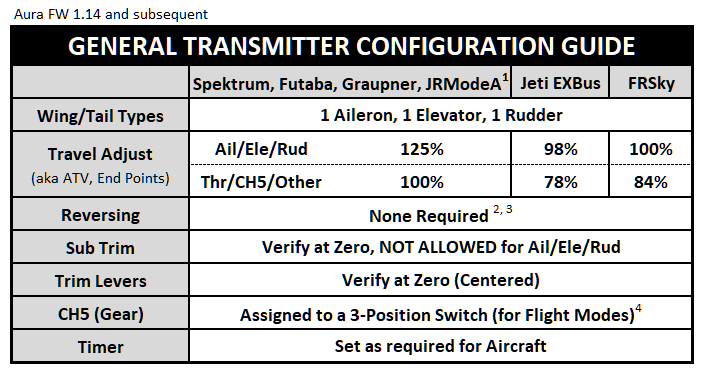
1. JR Mode A is preferred as of Aura FW v1.14. For JR Mode B, see the Aura Wiki
2. If you are using a Futaba transmitter, please note that some Futaba transmitters have the throttle set to reversed by default. Leave reversing set to defaults to start, and reverse as needed.
3. Aileron, Elevator, and Rudder should NOT be Reversed, other channels may be reversed at users preference
4. If Flight Modes are set to a channel other than CH5/Gear, set a 3-position switch to that channel and set CH5/Gear as needed.
5. See the Wiki for further details and latest information, and for Hitec use, etc.
Transmitter Flaps in the transmitter Wing Type could be 0, 1, or 2 depending on your needs. Examples:
- 0 if no flaps.
- 1 if one flap servo via Rx or Aura ports, or if you will use flaperons in Aura, or if you will have Aura output 2 flap servo ports while using 1 flap input. (ex. Cessna 170 stock setup)
- 2 if you will use Rx or Aura to output 2 servo ports that are configured and adjusted inside the transmitter and sent to the Rx and onward.
The Aura Config Tool allows the Flight Modes to be switched by nearly any Transmitter/Receiver channel. The Gear/Ch5 is a 'default' that is commonly used. For best results, setup your transmitter so your Gear/Ch5 channel is controlled by a 3-Position switch.
If Retrofitting an existing flying model with normal wing and tail types, it is possible to proceed with the existing transmitter program, however, the Aileron, Elevator, and Rudder Reversing in the transmitter should be set to NORMAL before proceeding. (Dual Rates, Expos, and other transmitter settings should also be considered as they will likely be 'duplicated' in Aura)
When configuring via the Quick Setup method, refer to the Quick Setup instructions regarding trim/sub-trim.
When configuring though the Aura Config Tool Application (retrofit or new model), you should NOT use transmitter sub-trim or trim during model setup. You should use Aura's sub-trim, Aura's Quick Trim feature, and/or mechanical linkage adjustments to eliminate the need for sub-trim/trim in your transmitter.
- Transmitter trim (not transmitter sub-trim) can be used if you follow the Quick Trim procedure to 'Zero it Out' before subsequent flights.
3. Wiring Connections
Depending on the complexity of the model and 'radio source' used, there are many ways to connect the Aura. Many 'typical' setups are shown below. Additional information on more advanced setups can be found at the Aura FAQ.
Always remove the propeller, unplug the motor, or take other action as needed to disable the power system before applying power and adjusting Aura settings. This is especially important for the initial setup and power of the Aura and your aircraft.
Receiver Connections (Aura Receiver Input)
Start by connecting your Receiver to the Aura. Refer to the images below and choose ONLY ONE input method from the ones shown, and make the required connections. Depending on your transmitter/receiver pair, you may need to consult your transmitter manual to enable certain outputs from your receiver including Futaba, Graupner SumD, JR Mode A or B, FRSky S.Bus, or Jeti EX Bus or UDI.
For Futaba, Use the S.Bus option, do NOT use S.Bus2.
For the Aura 8 Open Stock products, PPM and PWM connections require the Aura Config Tool to configure. These connection methods are not supported by Quick Setup or Auto-Detect.
Aura Professionals also do not Auto-Detect of PPM and PWM connections and do not have the Quick Setup feature.
In the case of PWM connections, ALL (typically 4) PWM signals must be present to get control of the model at start-up.
Aura 8 Receiver Connection Diagrams
(Click on images to expand)
If your Receiver has a working throttle port, use it for throttle. Choose ONE of these methods.
Aura Professional 8 and 12 Receiver Connection Diagrams
(Click on images to expand)
If your Receiver has a working throttle port, use it for throttle. Choose one of these Methods.
Power Connections
Always make sure your model is supplied with sufficient electrical power for the on-board electronics. Modern digital servos for example can draw large current spikes which can 're-boot' modern microprocessor controlled electronic devices.
- NOTE: Always check the wire/connector polarity carefully when installing a cable that can provide or draw power. The electronics can be damaged or destroyed with reverse connections.
Standard Aura 8
Power your Aura 8 by plugging one or more 4V-9V DC power sources into any open Aura servo port. The Servo Ports S1-S8 and the Servo Port B are all connected on a common bus, so make sure any servos connected to the bus can handle the input power voltage. The Aura can accept a range of power sources including a flight battery, a BEC (Battery Eliminator Circuit), and power from a receiver such as a "Spektrum PowerSafe".
See the Aura FAQ for more information on advanced power setups. See also this page for additional power and connecting techniques and this page for information on large aircraft power techniques
Note: See manual for warnings about power connections. The ports (particularly port B) can be damaged if power is applied with the connector 'reversed'.
Aura 8 and 12 Professional
Power your Aura 8 or 12 Professional by plugging one or two (two for flight) 5V to 9V DC power sources into the EC3 battery input connectors. Identical 2 cell LiPo or LiFe batteries are good choices. Make sure all of your servos and devices are capable of handling the voltage of your chosen power source.
More Battery Choice Information can be found here.
The provided switch may optionally be installed in the "SW" port. With the switch removed, the unit will be switched ON.
Lit White LED's in the upper right window indicate a battery connection when the unit is ON. (If one power source has a lower voltage than the other, its White LED will be unlit until the batteries come into balance.) The small Red LEDs (next to the White ones) can be programmed using the Config Tool to give a low battery voltage indication.
Important: The professional unit draws a small amount of electrical power even when switched OFF. Un-Plug the batteries when not in use for more than several hours.
Note: The receiver(s) will receive power from the Aura Professional via the A and/or B Port (or servo ports when using PWM) when the Aura power is ON. Be very careful to make sure the polarity of all connectors is correct. If you are putting a large load such as larger servos on your Receivers Bus, you can use and extra male to male connector with the signal wire removed to connect the Aura Bus (any empty servo port) to the Receiver Bus (any empty port)
Note: Do not use any type of BEC (Battery Eliminator Circuit) that will SUPPLY power to the Aura Professional's servo bus. If a chosen ESC for example includes a BEC, disable it by removing the "+" pin from the connector and taping it back. In this case, connect only the "-" and "signal" pins.
Servo Connections
Aura port connected servos are connected to the S1 to S8 (or S12) ports. It is suggested that you connect them in small batches during your Aura Configuration that follows.
Receiver port connected servos can be plugged in and adjusted via the Transmitter in the usual fashion at the time of your choosing.
After completing these Installation steps, you must Configure the Aura.

